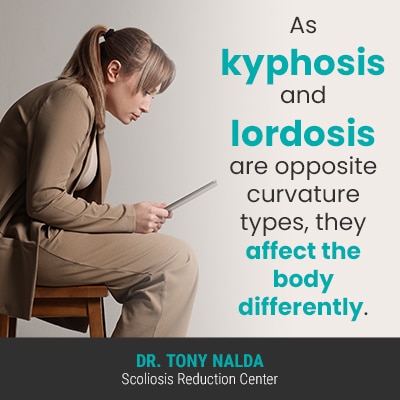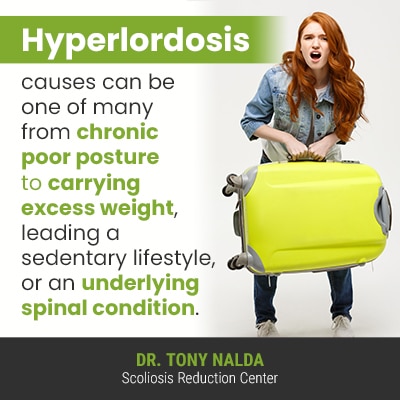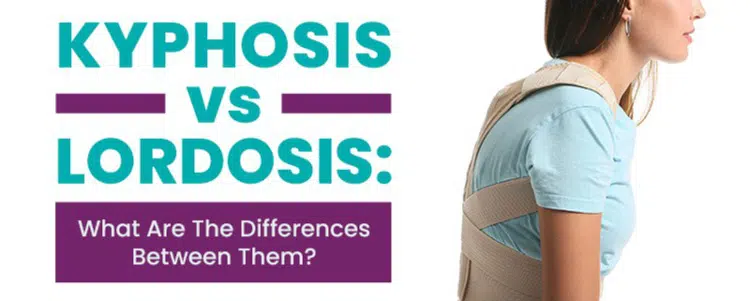The spine has natural and healthy spine curves that range in size from one person to the next. The spinal curves have a normal curvature-degree range, but problems can occur once a curvature type falls beyond that normal range. Kyphosis and lordosis (*aka hyperkyphosis and hyperlordosis) are spinal conditions that refer to a loss of the spine’s healthy curves.
Kyphosis and lordosis are types of spinal curvatures. Kyphosis is a type of spinal curve that bends outwards, while lordosis curvature types bend inward towards the body’s center. The thoracic spine is kyphotic, while the cervical and lumbar sections above and below are lordotic.
To better understand the role of the spine’s natural curvatures in spinal health and function, let’s start with some basic anatomy of the spine.
4 Key Takeaways
- Understanding Spinal Curvatures: The spine’s natural curvatures, including kyphosis and lordosis, play crucial roles in maintaining strength, flexibility, and the ability to distribute mechanical stress. Deviations from their normal curvature ranges can lead to conditions requiring treatment.
- Kyphosis vs. Lordosis: Kyphosis (outward curvature) primarily affects the thoracic spine, leading to a rounded back, while lordosis (inward curvature) affects the cervical and lumbar regions, causing a swayback appearance. Both conditions disrupt spine biomechanics and cause varying symptoms.
- Symptom Differences: Hyperkyphosis can cause symptoms like numbness, tingling, and breathing impairments, whereas hyperlordosis may result in back pain, sciatica, and mobility issues. Both conditions contribute to noticeable postural changes and discomfort.
- Causes and Treatments: Factors like poor posture, sedentary lifestyle, obesity, and underlying spinal conditions can lead to exaggerated kyphotic and lordotic curvatures. Treatment approaches vary, focusing on structural adjustments, lifestyle changes, and in severe cases, may include surgery. The specific strategy is tailored to each individual’s condition type and severity.
Spinal Anatomy
The spine is a key structure in human anatomy because it’s the body’s main weight-supporting structure and because it allows us to stand upright, practice good posture, engage in flexible movement, and absorb mechanical stress.
When a healthy spine is viewed from the front or back, it appears straight; it will have a soft ‘S’ shape when viewed from the sides.
The spine’s natural curvatures make it stronger, more flexible, and better able to absorb and distribute shock from impact.
In addition, the brain and spine work in tandem to form the body’s central nervous system: a vast communication network that sends/receives messages between the brain and the rest of the body.
The spine’s role in brain-body communication is why spinal conditions can cause such far-reaching effects felt throughout the body.
The spine has three main sections: cervical (neck), thoracic (middle/upper back), and lumbar (lower back). The lumbar spines, located in the lower back, are particularly important for supporting the body’s weight and allowing for flexible movement.
Each of these spinal sections has its own characteristic curvature type, and as the spine is one structure, the integrity of each spinal curve is dependent upon the others.
So now that we know the main spinal sections and the reason the spine is curved in the first place, let’s talk about the different curvature types: kyphosis vs lordosis.
What is Abnormal Curvature of the Spine?
The spine is a complex structure that plays a crucial role in supporting the body’s weight and facilitating movement. A normal spine has a gentle, S-shaped curvature when viewed from the side, with the cervical and lumbar regions curving inward (lordosis) and the thoracic region curving outward (kyphosis). However, in some cases, the spine can develop an abnormal curvature, leading to conditions such as kyphosis and lordosis.
The normal curvature of the spine
The normal curvature of the spine is essential for maintaining proper posture, balance, and overall spinal health. The cervical spine, which connects the head to the thoracic spine, has a natural lordotic curvature, typically ranging from 20 to 40 degrees. The thoracic spine, extending from the base of the neck to the lower back, features a natural kyphotic curvature, also ranging from 20 to 40 degrees. Meanwhile, the lumbar spine, which connects the thoracic spine to the pelvis, has a natural lordotic curvature that ranges from 40 to 60 degrees. These natural curves help the spine absorb shock, support the body’s weight, and allow for flexible movement.
Abnormal curvature of the spine: kyphosis and lordosis
Abnormal curvature of the spine occurs when these natural curves become exaggerated or diminished, leading to conditions such as kyphosis and lordosis. Kyphosis is characterized by an excessive outward curvature of the thoracic spine, resulting in a hunched or rounded back. This condition can lead to symptoms such as back pain, nerve compression, and postural changes. On the other hand, lordosis is characterized by an excessive inward curvature of the lumbar spine, resulting in a swayback or exaggerated arch in the lower back. This abnormal curvature can cause symptoms like back pain, mobility issues, and nerve compression. Both conditions disrupt the spine’s natural alignment and can significantly impact a person’s quality of life.
Kyphosis vs Lordosis
As mentioned, the spine’s natural curvatures can vary in size from one person to the next, and this is measured as curvature degree.
Keeping the spinal sections in mind, the cervical and lumbar spine feature curvature types that bend inwards towards the body’s center, known as lordosis, while the thoracic section’s curvature bends outwards, away from the body’s center, as kyphosis.
So what’s considered a normal range of kyphosis and lordosis? A healthy cervical spine would have a lordotic curve that ranges between 20 and 40 degrees; a healthy thoracic spine would have a kyphotic curve that would fall between 20 and 40 degrees, while the lumbar spine has a healthy lordotic curvature range of between 40 and 60 degrees.
As long as a person’s kyphosis and lordosis stay within these normal levels, the spine’s natural curvatures will help the spine function optimally, but once a curvature becomes over-pronounced, it disrupts the biomechanics of the entire spine and will require treatment.
Both kyphosis and lordosis cause postural changes, and when the spine’s natural kyphosis becomes over-exaggerated, it’s known as hyperkyphosis, and when the spine’s lordotic curves become over-exaggerated, this is known as hyperlordosis.

As kyphosis and lordosis are opposite curvature types, they affect the body differently.
Hyperkyphosis is also known as roundback, based on the appearance it gives the body, and hyperlordosis is also known as swayback, based on how it changes the body.
So how do these two spinal conditions affect the body similarly, and differently, in terms of symptoms?
Kyphosis vs Lordosis Symptoms
As hyperkyphosis involves an over-pronounced backward spinal curvature, it can cause a forward shift in posture that gives the upper back a pitched-forward appearance with rounded shoulders, known as roundback.
Hyperlordosis involves an over-pronounced inward spinal curvature. The unnatural spinal curve can cause the abdomen to protrude unnaturally and the buttocks to stick out excessively, giving the body a swayback appearance.
In addition to how these conditions affect the body’s overall symmetry, they also cause additional symptoms: some similar, some different.
Hyperkyphosis Symptoms
- Numbness and/or tingling in the legs (nerve compression)
- Fatigue
- Breathing impairment
- Balance/coordination issues
- Bladder and/or bowel impairment
Hyperlordosis Symptoms
- Varying levels of back/muscle pain
- Sciatica felt in legs and feet
- An inability to lay flat while the lumbar spine contacts the floor
- Mobility issues
As you can see, the loss of even a single healthy spinal curve can affect the health and function of the entire spine by disrupting its biomechanics and different curvature locations. Different curvature types produce different symptoms, based largely on where the unnatural curve develops along the spine, severity, and the degree of nerve involvement.
So now that you know the main differences in the two conditions, plus the different symptoms they produce, what causes the spine’s natural kyphosis and lordosis to become excessive?
Causes of Hyperkyphosis vs Hyperlordosis
There are a number of spinal conditions a person can develop that involve a loss of healthy spinal curves, and when it comes to hyperkyphosis and hyperlordosis, there are many causative sources.
In hyperkyphosis, we know the roundback appearance develops because of the thoracic spine’s vertebrae (bones of the spine) becoming more wedge-shaped, and the underlying cause will depend on the type of hyperkyphosis in question, as will treatment needs.
Postural Kyphosis Causes and Treatment
Postural kyphosis (hyperkyphosis) is the most prevalent type, and it’s caused by chronic poor posture.
Slouching too much or bending too far forward to look down at screens can disrupt the spine’s natural kyphosis, and this is most commonly diagnosed in adolescents and is more common in females than males.
Fortunately, this type is also the easiest to treat because it’s not a structural condition, meaning not caused by a structural abnormality within the spine itself, so it can be treated with postural correction, healthy lifestyle changes, and some physical therapy when needed.
Scheuermann’s Kyphosis Causes and Treatment
Unlike postural kyphosis, Scheuermann’s kyphosis is a structural condition, meaning its treatment needs will be more complex.
Scheuermann’s is diagnosed during adolescence, and in most cases, it develops as the fronts of certain vertebrae don’t grow at the same rates as their backs, eventually causing the bones to form into a wedge shape.
Scheuermann’s is more prevalent in males and tends to stop progressing once skeletal maturity has been reached.
As a structural condition, treatment will, first and foremost, have to impact the spine on a structural level, and here at the Scoliosis Reduction Center® the treatment would be chiropractic-centered and combine different treatment disciplines such as condition-specific chiropractic care (adjustments), in-office therapy, and custom-prescribed home exercises.
Congenital Kyphosis Causes and Treatment
In cases of congenital kyphosis, infants are born with the condition as it develops due to a malformation in the spine that occurs as the spine itself is developing in utero.
This can occur when one or more vertebrae fail to form properly, or what’s known as “failure of segmentation,” when multiple vertebrae fail to separate into distinct bones and intervertebral discs.
As congenital kyphosis is also a structural condition, its treatment needs are complex, especially considering the severity of the structural issue and the age group.
Here at the Center, I can treat a wide range of spinal conditions in patients of all ages. When it comes to treating congenital spinal conditions, I have to modify treatment plans that I might use for older children to meet the unique challenges associated with treating such young patients.
The reality, however, is that with some severe cases of congenital kyphosis, nonsurgical treatment can only go so far, and spinal surgery might be necessary to address the structural abnormalities within the spine itself.
Hyperlordosis Causes and Treatment

Hyperlordosis causes can be one of many from chronic poor posture to carrying excess weight, leading a sedentary lifestyle, or an underlying spinal condition.
Poor Posture
Poor posture can contribute to the development of hyperlordosis as it affects the body in a number of ways; keep in mind that the spine’s biomechanics are dependent on its ability to maintain its natural curves and alignment, so holding the spine in an unnatural position, over time, can start to affect its natural curves.
Leading a Sedentary Lifestyle
In addition, when someone spends a lot of time sitting, particularly with bad posture where shoulders aren’t back, and the spine isn’t straight, the muscles surrounding the lumbar spine can become tight as they struggle to support the spine’s unnatural position.
Over time, the kind of pressure from chronic poor posture, and how it can affect the muscles, could cause a misaligned spine and excessive kyphosis in the lower back.
Taking frequent breaks and practicing good posture can minimize the strain on the lower-back muscles.
Obesity
When a person is carrying excess weight in the buttocks and abdomen area, this also puts excess strain on the lumbar spine and its surrounding muscles.
When the lumbar spine is exposed to excess strain and adverse spinal tension, it can develop an exaggerated lordosis.
As the spine’s very design is based on movement, leading a sedentary lifestyle can cost the spine in terms of structure and function.
A sedentary lifestyle will lead to weakened core muscles due to a lack of use, meaning they are less capable of providing the spine with support/stabilization, making the lower back susceptible to developing an excessive curve.
Underlying Spinal Conditions
In addition to the aforementioned lifestyle habits that can contribute to the development of hyperkyphosis, there are a number of underlying spinal conditions such as discitis, spondylolisthesis, and hyperkyphosis.
As the vertebrae of the spine are separated by intervertebral discs that enable flexible movement, give the spine structure, and act as shock absorbers, if discitis develops (infected/inflamed spinal disc), it can impact the position of adjacent vertebrae.
Spondylolisthesis affects the lower spine and involves a shifting forward of a vertebral body onto the one beneath it, putting extra pressure on the vertebra and its disc, and impacting the area’s natural curvature.
In addition, a person with hyperkyphosis can also develop hyperlordosis as the thoracic spine’s excessive kyphosis can cause the development of a compensatory curve in the lower back: increased lordosis.
Risk Factors for Kyphosis and Lordosis
Several risk factors can contribute to the development of kyphosis and lordosis, including age, genetics, and lifestyle habits.
Age, genetics, and other risk factors for spinal curvatures
Age is a significant risk factor for kyphosis and lordosis, as the spine naturally degenerates over time. As we age, the intervertebral discs can lose height and elasticity, leading to changes in spinal curvature. Genetics also play a crucial role, as some individuals may be more prone to developing spinal curvatures due to their genetic makeup. Other risk factors include poor posture, which can strain the spine and lead to abnormal curvatures, and obesity, which places additional stress on the lumbar spine. Underlying medical conditions such as osteoporosis, which weakens the bones, and scoliosis, a lateral curvature of the spine, can also contribute to the development of kyphosis and lordosis. Additionally, lifestyle habits such as smoking and leading a sedentary lifestyle can negatively impact spinal health, increasing the risk of developing these conditions. Maintaining proper posture, staying active, and managing weight are essential steps in reducing the risk of abnormal spinal curvatures.
Conclusion
Similarities between hyperkyphosis and hyperlordosis are that they are both spinal conditions that involve a loss of its healthy and natural curvatures, and both cause postural deviation and varying levels of back pain.
One way the conditions differ is in the different curvature types: kyphosis referring to an inwards C-shaped spinal curve and lordosis referencing an outwards reverse C-shaped curvature.
Also, the two conditions tend to affect different areas of the spine, with hyperkyphosis mainly involving the thoracic spine, and hyperlordosis affecting the cervical and lumbar spinal sections.
The ways in which the two conditions affect the body’s appearance also differ with hyperkyphosis causing an excessive rounding forward of the upper back and shoulders known as roundback, and hyperlordosis causing the buttocks and abdomen to protrude excessively, giving the body a swayback appearance.
Kyphosis and lordosis treatment needs will be case-specific and guided by condition type, whether structural or non-structural, and considering its severity.
Here at the Scoliosis Reduction Center®, I have experience treating a wide range of spinal conditions, including hyperkyphosis and hyperlordosis.





